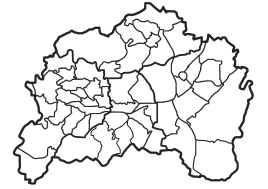Jacobsmühle
|
Jacobsmühle
City of Remscheid
Coordinates: 51 ° 11 ′ 15 ″ N , 7 ° 17 ′ 12 ″ E
|
||
|---|---|---|
| Height : | 265 m above sea level NN | |
|
Location of Jacobsmühle in Remscheid |
||
Jacobsmühle is a residential area in the southeast of the Bergisch city of Remscheid in North Rhine-Westphalia . The place name goes back to the Sankt Jakobs mill, which was one of the oldest mills in the Bergisches Land region . Today Jacobsmühle consists of only one residential building.
Location and description
Jacobsmühle is located in the statistical district of Engelsburg of the Lennep district in the valley of the Lenneper Bach at the confluence of the Panzerbach and the Kleebach east of the larger Hasenberg district . Other neighboring residential areas and farms are Müllersberg , Lenneper Hof , Christhaus , Jammertal , Nagelsberg , Schneppendahl , Durchsholz , Auf der Hardt and the immediately adjacent Kleebach . Due to the construction of the Wuppertal dam, the watermill , Spaniermühle and Nagelsbergermühle were lost .
The new route of the federal road 229 , which also had to be relocated due to the construction of the dam, runs directly on site .
history
The Sankt Jakobs-Mühle was first mentioned in a document around 1200 as a fruit grinding mill for villa Linepe , i.e. the town of Lennep. At first it did not have a mill pond , but was driven by the flowing water of the Lenneper and Panzerbach. Since 1240 the Leynepder Mulle belonged to the Lüttringhauser feudal lordship of the noble Bottlenberg family and was awarded as a fiefdom around 1350 .
After being used as a bone mill, the operation as a fulling mill of the St. Jakobi Brotherhood , which was an association of the Lennep cloth makers' guild , is documented for 1500 . This is where the traditional name of the Jacobsmühle comes from. In 1577 four members of the cloth makers' guild were tenants of the fulling mill, who had to pay six guilders and eleven Albus rent to the church. The other guild members were allowed to use the mill for their cloth goods for full wages.
The map Topographia Ducatus Montani from 1715 shows the mill as a mill . In addition to the watermill downstream, which is also labeled as Mühl , another six unlabelled water engines on the Lenneper and Panzerbach are shown on the map. In the 18th century the place belonged to the Bergisches Amt Bornefeld-Hückeswagen .
After apparently three hundred years of use as a fulling mill, the use as a bone mill is again documented around 1800. It had two rams that were driven by an overshot water wheel. More fulling mills were built at the Lenneper Bach when the guilds were abolished in the Napoleonic period. The Jacobsmühle was also converted into a fulling mill by the merchants Johann Mühlinghaus and Johann Kotthaus zu Nagelsberg around 1830. Together with the water mill located around 300 meters downstream, the facility was used as a cloth factory around 1845. In 1853 the owner changed again, the technical equipment of the plant included a water wheel with a 12-foot gradient and two grinding cycles .
In 1832 the Jacobsmühle belonged to the Lennep district, which was part of the Lennep mayor's office . According to the statistics and topography of the Düsseldorf administrative district , the place, which was categorized as a bone mill, apparently out of date, had a residential building and a manufacturing facility at that time. At that time there were no residents in the village.
In 1867 it was listed as a flour mill with two horsepower in the possession of a Johann Daniel Mühlinghaus .
In the municipality lexicon for the Rhineland province , a house with eleven inhabitants is given for the year 1885. At that time the place still belonged to the Lennep mayor's office within the Lennep district .
In 1895 the place had a house with nine residents, in 1905 one house and twelve residents.
In 1886 the Lennep - Krebsöge section of the Wuppertal Railway was opened past the mill . During the First World War it was again used as a bone mill by a Karl Sause , and in 1929 the city of Lennep was incorporated into Remscheid with the Jacobsmühle.
In 1942 the mill was demolished and the mill pond was used as a Lennep sewage treatment plant. In the 1970s this, as well as the now disused railway line, had to give way to the preparations for the construction of the Lenneper Bach pre-dam for the Wuppertal dam. Today the route of the federal road 229, which was laid by the dam construction, runs over the old mill location.
Individual evidence
- ^ A b c d e Günther Schmidt: Hammer and Kotten research in Remscheid ; Volume 5; From Blombach to Eschbach ; Remscheid; ISBN 3-9800077-6-6
- ↑ Johann Georg von Viebahn : Statistics and Topography of the Administrative District of Düsseldorf , 1836
- ↑ Königliches Statistisches Bureau (Prussia) (Ed.): Community encyclopedia for the Rhineland Province, based on the materials of the census of December 1, 1885 and other official sources, (Community encyclopedia for the Kingdom of Prussia, Volume XII), Berlin 1888.
- ↑ Königliches Statistisches Bureau (Prussia) (Ed.): Community encyclopedia for the Rhineland Province, based on the materials of the census of December 1, 1895 and other official sources, (Community encyclopedia for the Kingdom of Prussia, Volume XII), Berlin 1897.
- ↑ Königliches Statistisches Bureau (Prussia) (Ed.): Community encyclopedia for the Rhineland Province, based on the materials of the census of December 1, 1905 and other official sources, (Community encyclopedia for the Kingdom of Prussia, Volume XII), Berlin 1909.
